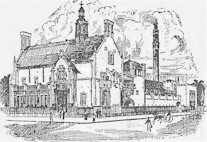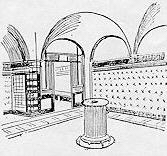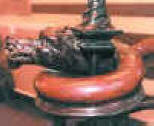The Turkish baths
This large building in 'Scottish Renaissance' style was designed by Glasgow architects John Burnet & Son and built on the corner of Primrose Street and Primrose Place as a gift to the town by Mr John Thomson Paton. On 29 April 1898 (the day having been declared a public holiday) after a grand procession through the town, the baths were officially opened by Mr J B Balfour, QC, MP.
The building had five main interconnected activity areas, each having also its own individual entrance. Apart from the main swimming and plunge pools, there was a large gymnasium, club room, billiards room and a Turkish and Russian baths suite.

The entrance
to the Turkish baths
is on the far right
The Turkish baths were in Primrose Place in a two storey section to the far right of the building. A large gateway led to the boiler house at street level, and to the square castellated staircase tower leading, in turn, to the Turkish baths on the first floor.
The Turkish Bath Department extended towards the rear, beneath the domed area and beyond, the interior being decorated in 'oriental style'. It included a cooling/dressing room with six cubicles for changing, each with its own dressing table and couch.

One of the hot rooms, with central radiator
There were two hot rooms: a tepidarium maintained at 140°F, and a sudatorium maintained at 180°F. These were heated by a main central radiator with three smaller supplementary ones. An entrance from the passage between the cooling-room and tepidarium led to the shampooing room, and also to the Russian bath. This was heated by steam introduced through perforated pipes at the discretion of the bathers themselves.

There was also a large plunge bath, together with washing and toilet facilities. All the rooms, as elsewhere in the building, were lit by electricity, and the fittings and decoration throughout the building, exemplified by this carved dragon decorating a bannister, were of a very high standard.
In addition to bearing the cost of the building Mr Paton also undertook to make good any deficit in running costs for the first three years, though this additional support may not have been needed. In the first seven months after the opening, an average of 4,000 admission tickets were sold for various parts of the building bringing in over £1,000 in revenue and it was being predicted that the Commissioners would have a surplus of between £400 and £500 at the end of the year. 1, 2
But thirty or so years later in 1931, despite a number of minor improvements, the baths were not being so well used. The local paper complained that Alloa's 'facilities for abounding health' were not as well used as they should be, and the public didn't realize how good they were, even though some bathers came from as far north as Kinross and as far south as Falkirk.
The temperatures in the hot rooms were now 20°F higher than originally, and a professional masseur, Mr W C Carruthers of Harrogate and Glasgow, had been appointed. 3
By the mid 1960s the baths were desperately in need of refurbishment and a major modernization plan was drawn up. But in 1965 cuts in expenditure were deemed necessary and the new scheme was slashed. Approval was given, though, to some improvements to the Turkish bath,4 and the work was started. Unfortunately, the following year, in the midst of refurbishment, fire broke out and the Turkish baths were destroyed, although the swimming baths remained open till 1986.
The building now houses the Spiers Centre which includes a museum. 'The Turkish bath suite has now gone.
